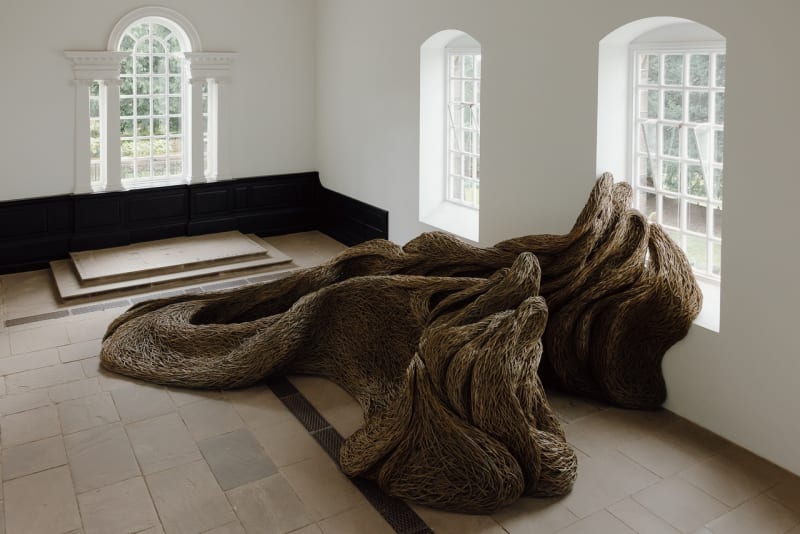And Ye Shall Find: Laura Ellen Bacon's Into Being
Glenn Adamson
Ask, and it shall be given you;
Seek, and ye shall find;
Knock, and it shall be opened unto you.
- Matthew 7:7
Deconsecration only ever goes so far. Witness St. Bartholomew's Chapel: handsomely built in the classical style, in 1744, it was a site of worship and community for two centuries before falling gradually into disrepair. Yorkshire Sculpture Park acquired and renovated the chapel in 2013, and began presenting exhibitions in the historic space, featuring the work of luminaries such as Ai Weiwei, Chiharu Shiota, Kimsooja, Rachel Kneebone, Leonardo Drew, and Leilah Babirye.
Now the chapel doors open again, to reveal another marvel. How to describe it? An indoor river in full spate, a mighty draught poured through the vessel that is the chapel? The impossible progeny of a thicket and an ink painting? A child's dream made real?
In fact this is the handiwork of Laura Ellen Bacon, a soft-spoken but prodigious sculptor who lives not far away, in Derbyshire. While she has worked in other materials, including dry stone (which she used for a permanent installation at nearby Chatsworth House), Bacon is best known for her work in hand-woven willow. The hands in question are her own. After the material is harvested and soaked to make it pliable, she builds her monumental forms, sculpting as she goes, every interlace adding complexity and contour. And force: these whiplash strands strain mightily against one another, all the strength she has put into them, twist by twist by twist, trapped within the organic architecture.
That took several weeks' worth of long days; all that duration is felt in the work. So too the time that the willow took to propagate itself. ("I do think a lot about it as it grows in the field," Bacon says, "in its known company.") And when you stop to think about it, the very sunlight that powered that growth, also held fast in the sculpture. It seems to know this, rising up toward the arched and mullioned windows, as if seeking more light. In the other direction, its mass hugs the floor and tapers as it approaches the altar, as if in genuflection. Bacon had to lie down to complete the base all around its perimeter, her head on a little cushion, like a sidelong Michelangelo.
You get the idea: even if St. Bartholomew's is no longer a house of official worship, Bacon has surely channeled its accumulated spiritual energies, like a diviner dowsing for an underground spring. She is not herself religious (though she did attend a Catholic primary school), but she has had the opportunity to work at other ecclesiastical sites, most recently a former Cistercian abbey north of Paris.
There is complete harmony between such places and her form-language, which is reverential in its own way - not to a deity, but to the natural world that inspires human devotion in the first place. It is perhaps no coincidence that her sculptures resemble the drapery in a Renaissance altarpiece, the one part of such historic paintings that is essentially abstract, and often, a metaphor for the holy spirit in motion.
Of course, willow is not a fluid medium, nor is it a fabric. While it can be stripped of its bark, revealing the pale cambium layer beneath, for the chapel installation Bacon chose to leave the bark on, emphasizing its essential woodiness and resemblance to rural fencing. She began with two large branches of beech, giving her an organic armature to build from (you can just see their shadowy shapes within the layered volume).
The willow itself is cut to six-foot lengths, which she uses entire to build the framework, and cut in two as she shapes the sculpture's exterior. The thicker bottom halves go in butt-first, establishing a strong structure, while the thinner tips are either used for fine layering, or saved for other, smaller-scale projects - some of which are displayed elsewhere in the chapel, giving a sense of Bacon's expressive range. Nothing is wasted, and at the conclusion of the exhibition at YSP, the sculpture will be (gulp) cut into pieces so that it can be removed from the building, and then set in the landscape as a wildlife shelter, where it will serve an audience of animals, birds and insects.
Meanwhile, in St. Bartholomew's, there are many ways to experience the sculpture: first, through the chapel doors, glimpsing its "glimmer" (Bacon's word); then walking around and into it, allowing its divided current to surge around and claim you, a rising tide. Then upstairs, to the overlooking balcony, where the fluid plan of the composition becomes evident - as if one were aloft looking down at a changing landscape.
These many imaginative pathways make the work's title, Into Being, perfectly apt. The phrase chimes with experience it offers: first and foremost, the simple amazement that such a herculean thing has materialized within the chapel's confines; but also, on a more fundamental register, a sense that this extraordinary transformation is still ongoing. The sculpture's shapes appear to shift as one explores them; its overall contours give way to finer detail, a cascade of forms within forms, on effectively to infinity. Deconsecrated this once holy building may be, but - as Bacon is only the latest artist to demonstrate - it can still be a space of transcendence.
Glenn Adamson


